Deck Footings 101: Navigating the Fundamentals for a Steady and Resilient Deck
Picking the Right Deck Footings for Security and Toughness
The durability and safety and security of your deck depend heavily on the kind of footings you choose, as they supply the necessary assistance and security to hold up against the test of time. In this conversation, we will check out the numerous kinds of deck grounds, think about the important factors to consider when making a choice, and delve into the pros and cons of different choices.
Types of Deck Grounds
There are several sorts of deck grounds that can be utilized, each offering distinct benefits and factors to consider. One common kind of ground is the concrete pier ground. These footings contain a round hole full of concrete, which offers a strong foundation for the deck blog posts. Concrete pier footings are reasonably very easy to set up and offer superb security, making them a popular option for numerous deck tasks.
These footings are mounted by screwing them into the ground, which creates a protected structure for the deck. They also allow for very easy change and progressing of the deck if required.
Conversely, some building contractors select precast concrete grounds. These grounds are constructed from resilient concrete and be available in various sizes and shapes to suit various deck designs. Precast concrete footings are hassle-free to mount and supply a secure base for the deck structure.
Ultimately, an additional choice is the post-in-anchor footing system. This type of ground includes driving a steel anchor right into the ground and connecting it to the deck article. It uses versatility in terms of placing the deck articles and appropriates for decks with light-weight structures.
When choosing the best kind of deck ground, it is vital to take into consideration elements such as dirt problems, deck lots, and local building regulations (Deck Footings). Consulting with an expert service provider or structural engineer can help guarantee the appropriate ground is selected for a safe and stable deck
Elements to Think About When Picking Grounds
When choosing the ideal grounds for a deck, it is important to thoroughly take into consideration different variables such as soil conditions, deck tons, and adherence to local building ordinance. These elements play a significant function in ensuring the security and resilience of the deck structure.
Among the primary factors to consider is the dirt conditions. The kind of dirt on which the deck will certainly be constructed determines the type of grounds called for. For example, decks built on sandy or loose dirts might require much deeper footings to offer ample support and protect against settling. On the other hand, decks constructed on clay or extensive dirts might call for footings that can fit the soil's propensity to broaden and contract.
An additional important aspect is the deck tons. The weight of the deck, consisting of the materials used and any prospective online lots such as furnishings or gatherings, must be taken right into account when selecting grounds. The grounds need to be created to bear the weight of the deck and distribute it evenly to stop any architectural issues or failures.
Finally, adherence to regional building ordinance is paramount. Building regulations differ from area to region, and it is necessary to adhere to the particular requirements set by the regional authorities. Deck Footings. These codes make sure that the deck is constructed safely and satisfies the essential criteria for architectural stability and load-bearing ability
Concrete Footings: Cons and pros

Concrete footings use numerous benefits and negative aspects when used as the structure for a deck. On the favorable side, concrete grounds provide exceptional stability and durability.
An additional benefit of concrete footings is their flexibility. They can be put into different shapes and sizes to suit different deck designs and configurations. Concrete grounds can be customized to fit the particular needs and demands of the deck framework.
Nevertheless, there are additionally some drawbacks to making use of concrete grounds. This can raise the overall expense of the deck project and may call for expert assistance.

Helical Piers Vs. Sonotubes: Which Is Much better?
In considering the foundation alternatives for a deck, the contrast in between helical piers and sonotubes is vital in figuring out the premium choice. Helical piers, also recognized as screw stacks, are steel shafts with helical plates attached to them. They are twisted right into the ground making use of hydraulic equipment, offering a durable and secure foundation check out this site for the deck. On the other hand, sonotubes are round forms made of cardboard or fiber material that are loaded with concrete. They are put in an opening dug right into the ground and offer assistance for the deck.
The helical plates on the piers develop a solid hold with the dirt, protecting against any activity or shifting of the deck. Sonotubes, on the other hand, depend entirely on the concrete filling for stability, which may not use the very same level of stamina and resistance.
In terms of installation, helical piers are fairly less complicated and faster to set up contrasted to sonotubes. The hydraulic machinery used to twist the piers right into the ground guarantees a fast and efficient process. Sonotubes, on the other hand, call for excavating holes and putting concrete, which can be labor-intensive and lengthy.
Additionally, helical piers are an even more flexible alternative. If needed, they can be utilized in various soil problems and can be adjusted or strengthened. Sonotubes, on the other hand, might need added assistance, such as rebar, in specific soil conditions or locations with high load demands.
Picking the Right Footings for Your Deck's Measurements
For optimum structural integrity, it is important to thoroughly choose the proper grounds that align with the measurements of your deck. The measurements of your deck, including its height, width, and size, play a substantial function in determining the kind and size of footings needed.
When selecting footings for your deck, try this web-site it is essential to take into consideration the load-bearing capability of the soil. The weight of the deck, combined with the weight of any kind of furnishings or people on it, exerts a considerable pressure on the grounds (Deck Footings). It is important to pick footings that can adequately support this weight without sinking or moving over time.
The shapes and size of the grounds need to likewise be thought about. Bigger decks with better measurements need larger grounds to offer sufficient security and support. The form of the footings, whether they are square or rounded, depends on the layout and design of the deck. In addition, the depth at which the footings are installed ought to be identified based upon the frost line in your region to stop any kind of heaving or changing due to freezing temperature levels.
Final Thought
In verdict, selecting the right deck footings is important for guaranteeing stability and longevity. Elements such as the kind of grounds, the deck's measurements, and the pros and cons of various choices ought to be considered.
These grounds consist of a round opening filled with concrete, which supplies a strong foundation for the deck posts. Concrete pier grounds are relatively very easy to set up and provide superb security, making them a preferred choice for numerous deck jobs.
Precast concrete grounds are hassle-free to mount and offer a steady base for the deck framework.
It uses versatility in terms of placing the deck messages and is suitable for decks with light-weight structures.
Concrete footings supply a number of advantages and over here drawbacks when utilized as the structure for a deck.